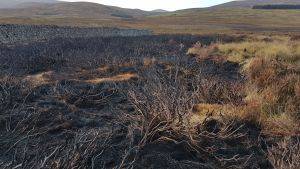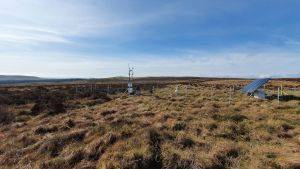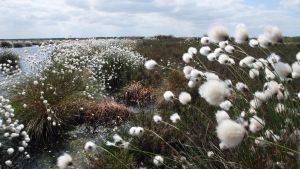Background
A large area of peatlands across the UK is planted with commercial forestry. In the period since the Commission of Inquiry on Peatlands (2011) there has been a significant increase in the amount of forest-to-bog restoration, which has been taking place on Government, private and NGO-owned land. Whilst the techniques used to restore these areas are beginning to develop, the delivery of this work has, to an extent, relied on trial of emerging techniques and follow up monitoring to estimate success. We are now in a position to bring together some of the practitioner experience and unpublished data available in relation to forest-to-bog restoration and establish a consensus on good practice techniques for successful restoration of afforested peatlands.
Current forestry policy recognises the need to remove trees from areas of deep peat; or at least not to replant trees after a first rotation where there are biodiversity and carbon benefits to be achieved from restoration to open habitat. An IUCN UK PP workshop on forestry and peatlands explored the scientific basis behind current estimates of carbon balance on afforested and restored peatlands. The workshop concluded that there is some deficiency in the assumptions and parameters used in current UK models. Since then a number of additional studies have sought to improve our understanding.
The Peatland Code recognises that tree removal is an important restoration opportunity but is awaiting reliable estimates of carbon impacts before it can be formally included in the scheme. This lack of consensus prevents potential funding from private investors through the Code and may prevent the aspiration of restoring afforested peatlands from being fully realised.
Objectives
The geographical remit is UK peatlands with reference to international experience. As part of this technical review, the following areas [1] should be explored and presented in a report of no more than 30 pages:
Good-practice forest to bog restoration
A summary of the range of restoration techniques used in the UK (and where relevant, internationally) to restore areas of plantation forestry to open peatland habitat, including both conventional and innovative methods. The summary should explore:
- Felling techniques e.g. mechanical felling, hand felling
- Management and processing of woody material e.g. fell-to-waste, brash crushing, mulching etc.
- Post-felling ground treatments e.g. ground smoothing, stump flipping etc.
- Post-restoration management requirements e.g. management of INNS and regeneration of trees.
- Costs (£/ha) of management interventions, including initial works and any ongoing management prescribed.
- Monitoring: Summarise ongoing monitoring on forest-to-bog sites. What attributes are being monitored and what monitoring methods are being employed? Provide timescales for ongoing monitoring work and current end-dates (where known)
- What works and what doesn’t? Which of the restoration techniques used are starting to demonstrate effective recovery of peatland ecosystem function e.g. vegetation composition, hydrological dynamics etc.
- What are the trajectories of recovery being observed on forest-to-bog restoration sites and over what timescales are restoration milestones being achieved?
- Which aspects of forest-to-bog restoration require further restoration trials or applied scientific research to improve our understanding of good practice management of these sites?
Carbon metrics and modelling
Summarise the existing evidence base for the carbon balance effects of forestry removal and subsequent restoration of afforested peatlands. Including:
- An estimation of carbon gains in the growth of peatland vegetation on a restoration site (i.e. early stock gains in Sphagnum growth in comparison to tree carbon stock losses through forestry removal)
- An assessment of current models and gaps including assumptions, issues with the assumptions made and where new data is needed to address these issues.
- Are there sufficient measurements of emissions from forestry on peat to establish a baseline ‘forested peatland’ condition category for the Peatland Code?
- Post-felling, does the area of peatland have similar emissions factors as the existing ‘drained peatland’ Peatland Code condition category? If no data is available, what processes are likely to contribute to emissions on a deforested peatland vs. an area of drained, open peatland? Are the emissions likely to be higher or lower than the values currently applied to the ‘drained peatland’ condition category?
- Highlight the remaining knowledge gaps and data required to improve existing land use change models: what data variables are needed to provide a holistic (modelled) view of the impact of:
- Plantation forestry on peatland
- Removal of plantation forestry from peatland
- Restoration to open habitat (post-felling).
Outputs
Each team is delivering the following:
- A workshop with relevant stakeholders to scope out topic content plus additional workshops as required
- A written report presenting a consensus view (where possible) amongst the author team and wider stakeholders; where a concensus view is not attainable the report will present the argument clearly and summarise any knowledge gaps. Protocols will be suggested where possible to address these knowledge gaps
- A summary briefing in plain-English of the key findings of the report and recommendations for future work, using case studies to provide examples of key points (expectations in more detail below)
- A graphical representation of the topic as a whole, or a key aspect of the topic to be either a) a graphical abstract; b) a summary diagram; or c) an infographic
- Presentation of findings at an Open Inquiry Event, and in addition the option to present at the 2018 IUCN UK Peatland Programme annual conference.
Summary briefing
- Good-practice forest-to-bog restoration: A plain-English summary providing recommendations of what is considered to be good practice post-felling restoration management. This should be written in the style of Section 5.3 of the Peatland Restoration Handbook [2].
- Carbon metrics and modelling: A plain-English summary of the key elements of the report (no more than two pages in length).
- Recommendations for future work (no more than two pages in length)
[1] Additional topics that come to light during the review and stakeholder discussions should also be included in the report.
[2] The Peatland Restoration Handbook to be published 2018 as an online, free resource. Final version is awaiting publication and IUCN UK PP can provide an example chapter for style.










